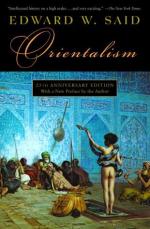
|
| Name: _________________________ | Period: ___________________ |
This test consists of 15 multiple choice questions and 5 short answer questions.
Multiple Choice Questions
1. The author notes in Chapter 1 that from 1815 to 1914 European direct colonial dominion expanded from about 35% of the earth's surface to what percent?
(a) 85%.
(b) 75%.
(c) 95%.
(d) 65%.
2. When did the British occupation of Egypt begin during the Anglo-Egyptian War?
(a) 1882.
(b) 1889.
(c) 1876.
(d) 1892.
3. Who wrote The Decline and Fall of the Roman Empire?
(a) Julius Mohl.
(b) Henri Baudet.
(c) Gaston Bachelard.
(d) Edward Gibbon.
4. When was The Eighteenth Brumaire of Louis Bonaparte published?
(a) 1798.
(b) 1848.
(c) 1879.
(d) 1882.
5. Who wrote Le Genie des Religions?
(a) Edgar Quinet.
(b) Henri Baudet.
(c) Julius Mohl.
(d) Gaston Bachelard.
6. Who is cited in Lord Cromer's book Modern Egypt as having said "Accuracy is abhorrent to the Oriental Mind" (38)?
(a) Edgar Quinet.
(b) Lord Salisbury.
(c) Sir Alfred Lyall.
(d) Henry Kissinger.
7. Who was the founder of the Royal Asiatic Society?
(a) Henri Baudet.
(b) Henry Thomas Colebrooke.
(c) Gaston Bachelard.
(d) Julius Mohl.
8. Who wrote the novel Louis Lambert?
(a) Henry Thomas Colebrooke.
(b) Honore de Balzac.
(c) Barthelemy d'Herbelot.
(d) Henri Baudet.
9. When did Lord Cromer publish an article in the Edinburgh Review referring to Orientals as "subject races" (36)?
(a) January, 1908.
(b) September, 1908.
(c) April, 1901.
(d) March, 1919.
10. Who wrote the Iliad?
(a) Socrates.
(b) Homer.
(c) Plato.
(d) Achilles.
11. How much money was Lord Cromer given on July 30, 1907 as a retirement prize for what he had done in Egypt?
(a) 20,000 pounds.
(b) 30,000 pounds.
(c) 50,000 pounds.
(d) 100,000 pounds.
12. The author states in Chapter 1, "By and large, until the mid-eighteenth century Orientalists were" what (51)?
(a) "Philological scholars."
(b) "Biblical scholars."
(c) "Anthropologists."
(d) "Philanthropists."
13. Who "were able intelligibly to reveal the extraordinary riches of Avestan and Sanskrit," according to the author in Chapter 1 (51)?
(a) Sir Alfred Lyall and Edgar Quinet.
(b) Anquetil-Duperron and Sir William Jones.
(c) Sir William Jones and Lord Salisbury.
(d) Lord Salisbury and Sir Alfred Lyall.
14. What term refers to the study of language in written historical sources?
(a) Philology.
(b) Anthropology.
(c) Epidemiology.
(d) Linguology.
15. Who said that "the Orient advances, invincible, fatal to the gods of light by the charm of its dreams, by the magic of its chiaroscuro" (73)?
(a) Nietzsche.
(b) Michelet.
(c) Schwab.
(d) Baudilaire.
Short Answer Questions
1. Approximately when was the Iliad written?
2. Who wrote The Citizen of the World?
3. When was the American Oriental Society founded?
4. What French philosopher is cited in Chapter 1 as having written an analysis on "the poetics of space" (54)?
5. The author asks in Chapter 1, "Can any other than a political master-slave relation produce the Orientalized Orient perfectly characterized by" whom (96)?
|
This section contains 390 words (approx. 2 pages at 300 words per page) |

|




